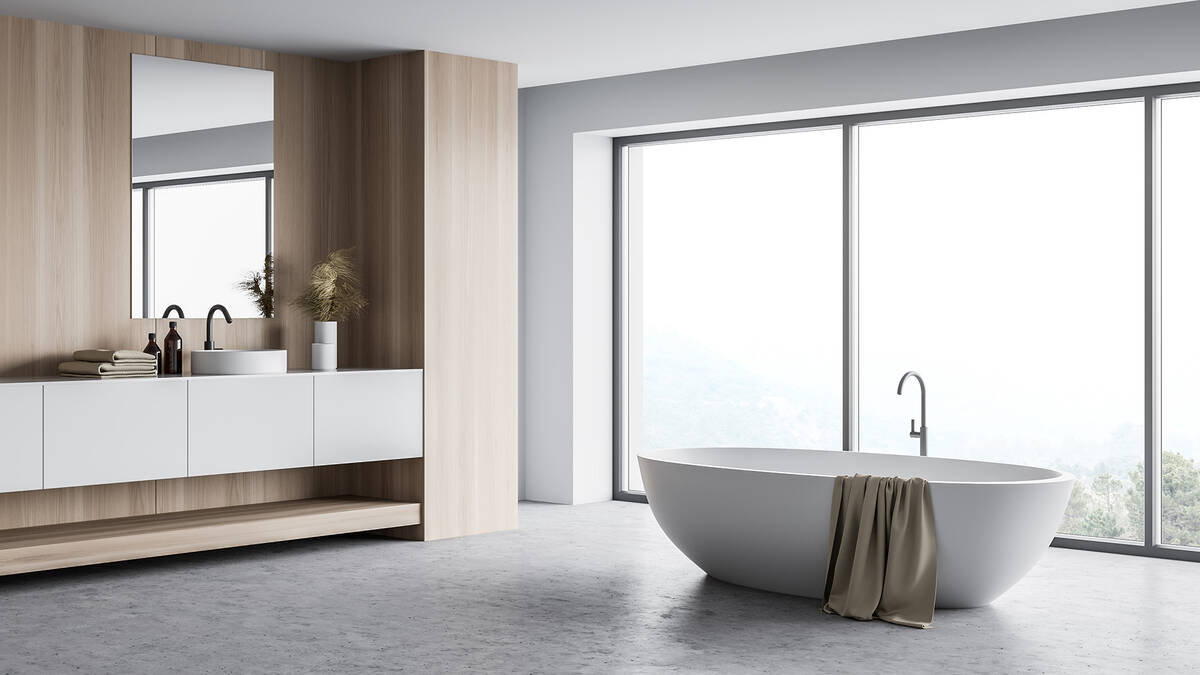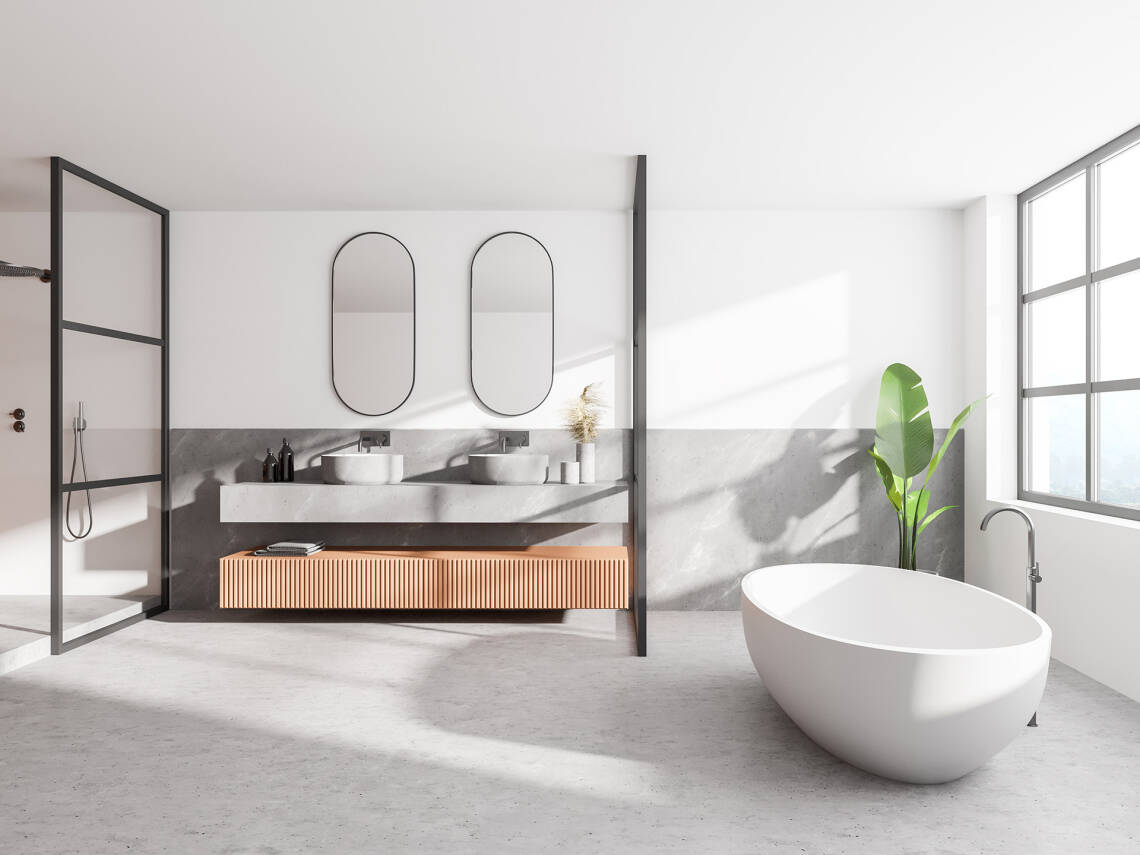The many benefits of seamlessness
Seamless bathrooms – a stylish trend with practical benefits
The trend towards ditching tiles and joints in the bathroom is increasing in popularity. But what are the benefits of a tile-free bathroom? What are the pros and cons of the different materials? Find out which building materials are suitable for flooring and wall panels and get answers to frequently asked questions here.

Elegant solutions with optical depth of focus

A seamless bathroom has several practical benefits. Without interruption from joints, the large surfaces on the walls and flooring automatically look spacious and lush. The eye perceives the dimension as a whole and does not get caught up in the smaller tiles. Rooms with limited space particularly benefit from the sense of vastness that this effect creates.
The departure from the traditional bathroom look also improves hygiene levels, as dirt particles can take hold in the joints between the tiles. The high humidity in this room means a biofilm can quickly form, supplying the perfect foundations for mould.
Nevertheless, the use of seamless materials requires specialist expertise which results in slightly higher costs.
Modern and classic materials to replace traditional tiles
When designing a seamless bathroom, you can choose from numerous materials.
In this article, we will look at the following materials in detail:
- Wood
- Decorative panels
- Waxed concrete
- Lime plaster
- Wallpaper
- Artificial resin
- Wood: warm and robust
Wood is a sustainable material that produces an ultra-cosy effect. For the bathroom, you should choose a wood variety that does not absorb a lot of moisture. Oak, walnut, Douglas fir, teak and merbau are all perfect choices here. Admittedly, traditional parquet flooring or wall cladding made of wood requires slightly more care in humid rooms. Instead of varnish or paint, we recommend finishing the surface with oil here. Why? Because if water pools on sealed wood, it can cause the sealant to crack.
Decorative panels: For every taste
Large-scale decorative panels come in numerous designs. You can use glass or acrylic glass to achieve depth effects that produce intense colours. The decorative element is applied to the back and shines through the glass here. Aluminium decorative panels are extremely robust and scratch-resistant. It is difficult to tell the difference between natural materials and an aluminium compound with a printed surface that replicates this effect here. Many manufacturers can also print your photo motifs on the panels. Ceramic decorative panels come in numerous colours, shapes and designs. The usual joints required for tiles are not needed here. However, there maybe material joints between individual panels.
Waxed concrete for minimalist elegance
Waxed concrete, a mineral micro-mortar, produces a subtle concrete effect on walls and flooring. Waxed concrete originates from France and is also known as beton ciré. White or grey cement is mixed with artificial resin, quartzite and various fillers here, and it provides a seamless surface in a wide range of colours. The material can be applied over existing tiles, as it is only a few millimetres thick. Waxed concrete insulates heat and sound as well as repels water.
Lime plaster: an eco-friendly classic
Lime plaster is an eco-friendly classic perfect for damp spaces. This purely mineral-based material sets on its own, without additives and was first used in ancient times. Lime plaster can be dyed any colour. It can absorb and then release moisture and combat mould formation. The Moroccan Tadelakt technique seals the lime plaster’s surface and makes it water-resistant. A polishing stone is used to compact the lime plaster. Olive oil soap is then used to make it water-repellent, so water rolls off it.
Wallpaper for a variety of effects
Non-woven or fibreglass wallpaper models designed for damp spaces are available in an endless variety of patterns and colours. This material can effortlessly withstand humidity and steam. Having said this, it is not particularly suitable for the splash zone above the wash basin or right next to the shower. It should be put up using a wallpaper paste suitable for damp spaces.
Durable and synthetic resin
Synthetic resin effortlessly withstands humidity and does not require extraordinary care. This synthetic material can be dyed in any shade of colour. If you are renovating your bathroom, you can simply cover the existing tiles with it. It can even be applied to bathroom furniture to make it water resistant. It is a challenging material to work with, so it should only be used by certified specialists.
Frequently asked questions about bathrooms without joints and tiles
It makes the space look bigger and improves hygiene, as joints are susceptible to mould formation.
You should select a suitable variety, such as oak, walnut, Douglas fir, teak or merbau. The surface should also be oiled.
This concrete is made of white or grey cement mixed with artificial resin, quartzite and various fillers. It can be dyed any colour.
You can use the Tadelakt technique to do this. The surface is sealed using a polishing stone and is then coated with soap.
Fleece or fibreglass wallpaper can withstand high levels of humidity. However, these materials are not suitable for the splash zone around the wash basin or shower.
Seamless freedom in the bathroom – with the right material
There are compelling reasons for the tile-free bathroom trend: Seamless wall panels make the space look large and improve hygiene, as getting rid of joints means getting rid of the perfect breeding ground for mould. A variety of materials are suitable for seamless bathrooms: alongside waxed concrete and decorative panels, you can also work with wood, wallpaper, lime plaster and artificial resin here.
Authorised dealers